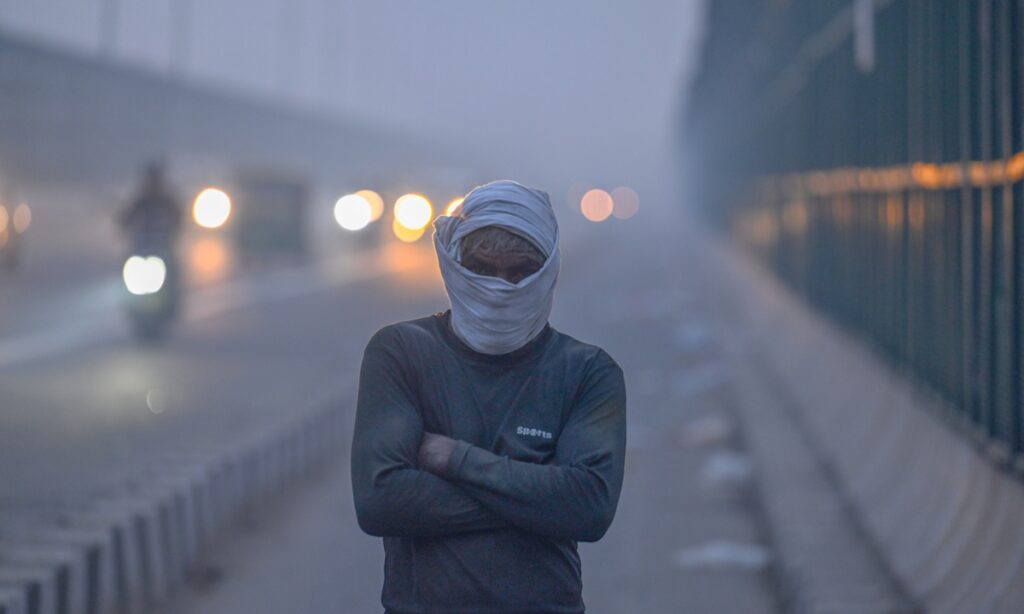The toxic smog in India after the Diwali festival again drew attention to the contrast in how New Delhi and Beijing have fought against their long-suffering air pollution. While the latter is breathing much better under bluer skies with much lower PM2.5 concentration, the former’s three cities recently ranked among the world’s 10 most polluted places with the Indian capital taking the top spot after revelers defied a ban on fireworks to celebrate the annual festival of lights.
Once upon a time, New Delhi and Beijing had often been compared with each other when talking about poor air quality back when heavy smog draped over two densely populated Asian capitals. However, as of press time, the Global Times found very few comments from Chinese netizens making such comparisons in comments related to India’s air pollution after the Diwali on Sunday.
Experts said that Chinese netizens’ lack of interest in “comparing China’s air quality with India’s” reflects their confidence in their own country’s overall air quality, which has improved after relentless effort. Different from China’s resolution in the battle to breathe, the India government has weaker organizational, mobilization and execution capabilities, and the public participation is insufficient, they said, calling for India to strengthen international cooperation on air governance and pollution control.
India has been battling toxic haze for weeks, leading to its capital suspending schools to protect children. While the government has also strongly urged the public not to set off fireworks to prevent worsening air pollution, people in many parts of the South Asian country still chose to let off firecrackers to mark one of the biggest festivals in India on Sunday evening, resulting in smoke plumes visible across the sky.
According to a ranking by Swiss air purifier company, IQAir, New Delhi ranked as the world’s most polluted city on Monday with an air quality index (AQI) of 407, falling in the “hazardous” category, while the financial capital Mumbai came in sixth with an AQI of 157, and Kolkata in the east at seventh with an AQI of 154. The AQI in New Delhi once reached an alarming 680 a little after midnight on Sunday.
An AQI level of 150-200 brings discomfort to people with asthma, lung and heart problems, while a level of 400-500 can impact healthy people and is dangerous to those with existing conditions.
Following the thick layer of smog after Diwali, BBC released a report on Wednesday, exploring why Indian the capital lags behind Beijing in the battle to breathe. The glaring air pollution and public anger compelled the Chinese government to take effective action to swiftly and wholeheartedly address it, but India lacks both the political determination and the pressure from the public, who have more pressing concerns as millions of them still live in poverty, the report said.
The Diwali festival only exacerbates India’s already severe air pollution resulting from poor infrastructure and energy production, but both the government and ordinary people lack the capacity and willingness to pay for upgrades, Long Xingchun, a professor at the School of International Relations at Sichuan International Studies University, told Global Times on Wednesday.
“For example, many of the lanes, non-motorized lanes, and sidewalks in India are made of soil, and when vehicles pass by, dust flies up. The cities have a large population and so many people need to burn coal or firewood for cooking and heating. And there is inadequate management in vehicle emissions. The fundamental problem is lack of economic capacity,” Long said.
While China has made huge progress in improving air quality, haze still arises at times. In late October, Beijing and some other parts of North China were engulfed by “medium pollution.”
In early November, the Beijing Municipal Bureau of Economy and Information Technology updated the emergency response plan for the manufacturing industry concerning the city’s air pollution, encouraging manufacturing enterprises to implement staggered working hours and to stop using non-road mobile machinery powered by fuel when orange or red alerts are issued for air pollution.
“Air governance has different focuses at different stages. Initially, banning individual highly polluting production activities can be effective. Then, changing the industrial structure and replacing coal with electricity or natural gas. As the requirements for air quality increase over time, the difficulties become greater and you need to expend more effort,” Zhang Yuanxun, a professor of environment monitoring and atmospheric chemistry studies at the University of Chinese Academy of Sciences in Beijing, told the Global Times on Wednesday.
Zhang said that one of the future challenges is improving poor air quality resulting from decreased diffusion caused by global climate changes and extreme weather events. However, it is very challenging to prevent global temperatures from rising.
According to experts, China and India can enhance cooperation on air pollution, and New Delhi can learn from Beijing’s experience. From 2013 to 2022, China’s GDP grew by 67 percent, but PM2.5 concentration dropped by 57 percent. In Beijing, pollution levels plummeted from 90 to 30 ug/m³, an achievement recognized by the UN as a “Beijing Miracle” and exemplary model for other developing countries, according to media reports.
(Global Times)




